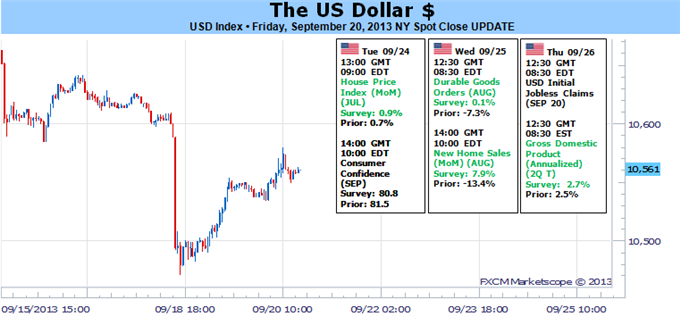
US Dollar Plummets on Fed, but Here’s Why it Might not Fall Further
Fundamental Forecast for US Dollar: Neutral
US Dollar plummets as US Federal Reserve fails to “Taper” its Quantitative Easing measures
US Treasury debt and S&P 500 surge, but markets give back gains as Dollar likewise recovers
Dollar moves will depend on upcoming economic data
Trade the US Dollar’s momentum following the FOMC decision using the Dollar Currency Basket
The US Dollar plummeted against the Euro and other major FX counterparts as the US Federal Reserve disappointed those looking for it to “Taper” its Quantitative Easing policies, but is it enough to drive the Greenback to further lows?
Traders reacted to the “NO TAPER” headline in straightforward fashion: selling US Dollars, buying stocks, and buying bonds. All of these markets had done the exact opposite in May when Bernanke first spoke of tapering QE; in that sense, recent price action seems perfectly reasonable. But how could everyone get it so wrong, and why does the Fed’s inaction pose real risk to the US Dollar?
The Fed made it fairly clear that it targeted specific US unemployment rates to trigger the “Taper” of QE, and it’s now obvious that we should take those targets at face value. Most traders were on the wrong side of the “Taper” trade because it was widely believed that recent improvements in labor data would be enough for the Fed to move; they clearly weren’t. The current jobless rate of 7.3 percent is above official targets of 7.0 percent, while inflation has actually fallen.
The US Dollar and broader financial markets will now prove more sensitive to future US employment and inflation numbers than ever before. If any upcoming US Nonfarm Payrolls reports or Consumer Price Index inflation figures disappoint, expect USD weakness.
It will be two weeks before we get our next reading of the domestic unemployment rate, and in the meantime an outright collapse in volatility prices suggests that few are betting on or hedging against big currency moves until then. Can the Greenback fall further?
We’re watching the Dow Jones FXCM Dollar Index hold onto support at its key 200-day Simple Moving Average, which likewise coincides with key swing lows. Unless we see a substantive break lower, there’s reason to believe that markets could simply consolidate and trade in broad ranges until the Fed begins to act. Inaction would indeed favor the over-arching themes in markets. Indeed, our Senior Technical Strategist believes that this Dollar pullback may represent an attractive opportunity to get long USDJPY and USDCAD.
But doesn’t the Fed’s inaction doom the Dollar to further losses? Not necessarily—other markets clearly reacted in dramatic fashion, but even US Treasuries and the S&P 500 are giving back some of their post-FOMC gains.
The Fed’s decision (or lack thereof) was clearly significant, but it doesn’t need to be a game-changer. Traders are now speculating that the Fed’s taper may start in October—depending on economic data results. Given their fairly rigid definitions, we’ll know sooner or later when the FOMC will pull back monetary stimulus.
Predictability is good. Now we wait for the next batch of data. – DR
DailyFX provides forex news and technical analysis on the trends that influence the global currency markets.Learn forex trading with a free practice account and trading charts from FXCM.
Source: Daily fx